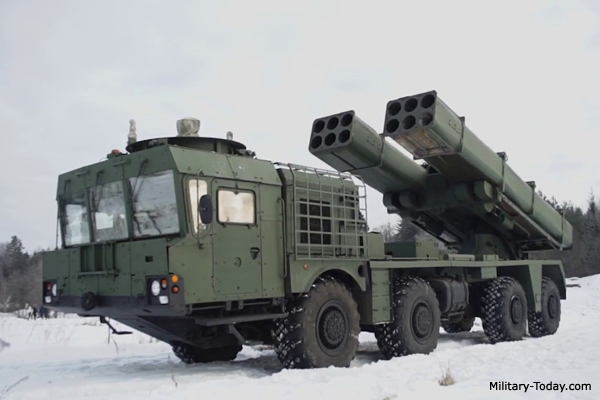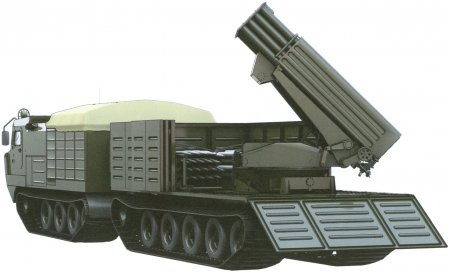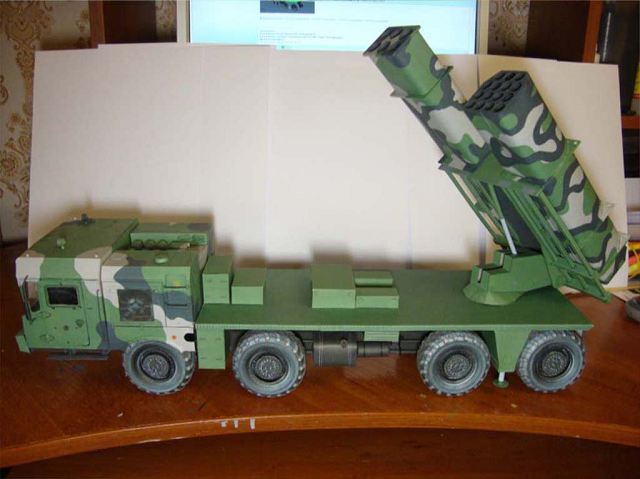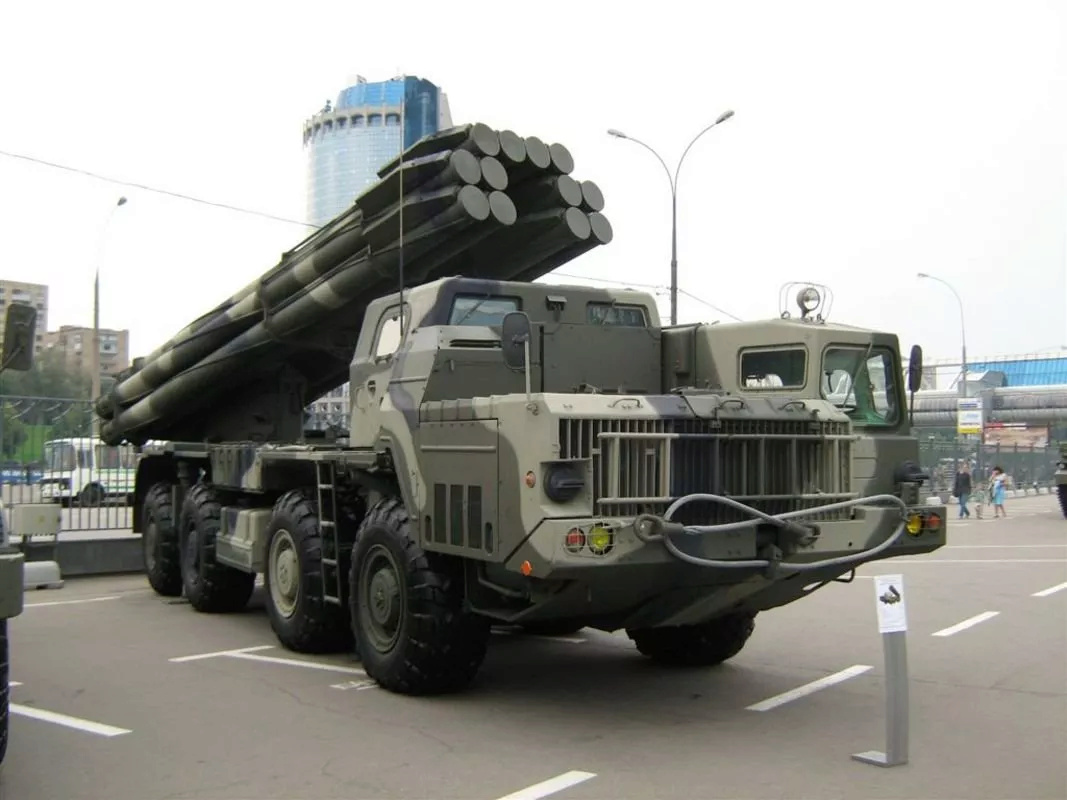The thing about that tube fired drone is that it's billed as being able to be fired to assess damage on the enemy, enabling operators to judge whether another salvo is needed
But in reality, how useful would that be? MLRS units likely won't stay in place for another salvo, but relocate. By that time, any data from the drone will no longer be current.
Would really depend on the drone though.
You could have a full length rocket drone with a tiny soft launch low signature rocket booster that flys slow and would take time to get to the target area, but could then use the 800kgs of the 300mm rockets as mostly fuel and laser target marker and electronics for a drone that could loiter all day 90-120km away from the launcher... at 250km/h it would take about half an hour to reach the target area, but if you use 200kgs for fuel it could still loiter for a long time with a much smaller more compact drone and 600kgs of rocket fuel could deliver the drone payload to the target area in seconds where it deploys wings while still quite high up in the air and starts a small motor to maintain altitude and run the optics and laser target marker... being very high flying any attack would be a top attack so a diving top attack on any high value targets you might spot, so if you see just one HIMARS then suicide into it, but if you see a battery of M777s then your Smerch battery could light them up with some 9N139 HE frag submunitions (72 per rocket) or if it is an armoured force or mix of armour and troops then 9N176 rockets each carrying 616 HEAT top attack submunitions covering an enormous area which would be good for getting M777 guns in place, but also the crews and the trucks that tow the guns and carry the ammo.
The drones stays airborne assessing the effect and if perhaps another battery set up somewhere else might want to continue doing more damage or if there is a priority target visible the drone could fly into.
Most of the time I think a dedicated recon drone will do a better job with better loiter time, better optics and able to coordinate different attack options depending on the job.
It might be more useful for firing in advance, especially to judge times for when a salvo should be launched against say an advancing column.
I would say its rocket launch system would allow it to be launched toward suspected enemy targets rapidly and that speed might be useful for sneaky targets that appear and try to quickly disappear.
Perhaps give it a releasable warhead so it could drop it like a small bomb and fly back to base for reuse to reduce costs, or suicide into targets if they are important enough to warrant the cost of the drone... the speed of the drone would mean it would take some time to get back to the launchers so sending it to a point on the way to the next launch position might be better... being able to drop the warhead makes it safer to handle for reuse.
Operating at altitude would also make it safer from small arms... the payload for suicide use could be a laser guided HEAT mini bomb so it could be effective from altitude if you can recover the drone intact.
On the whole it couldnt hurt to introduce it, but I'm a little skeptical about such a long-range rocket artillery division doing its own recon and such.
I agree... the rocket artillery units should be focussed on loading moving and firing.
An extremely important aspect of MLRS is range. I was hoping that we will see a Tornado rocket with a 300km range. China already has the PL-16 with a 300km range.
Some might suggest that for targets located at 300kms and beyond there is always the Iskander and other ground launched cruise missiles. The thing is these weapons are very precise however they are expensive weapons. A Tornado MLRS with a 300km range rocket can carry out similar strikes at a fraction of the cost.
Against third world countries or nearly defeated countries like the Ukraine and the Ukraine a 300km range ballistic rocket would be interesting, but at such ranges its payload would probably turn out to be too small... to get that sort of range you would probably have a payload of perhaps 30-40kgs, which is not big enough for a lot of targets a lot of the time.
An Iskander has a 600kg warhead and it very useful out to 500km or so.
The Russians still use rockets as a good way to cover a decent volume of ground with HE Frags for use against enemy forces in the open or a line of soft convoy vehicles etc etc.
The point is that if the Ukraine was using 300km range ballistic rockets... guided or unguided... the Russians would probably shoot most of them down before they reached their targets.
High flying weapons are easier to spot and track and engage than low flying targets like helicopters or fighters.
Of course to shoot down such rockets it is important to have the interceptor SAMs near the targets the enemy is firing at.
So basically the setup with in-service MLRS is plug-and-pray: Fire control sets the target coordinates and the battery dumps everything all at once. Weight of fire compensates the lack of precise targeting data. This is effective but is a huge waste of munitions since the vast majority of warheads would just end up kicking dirt.
True but precisely known fixed small targets will be engaged with laser guided shells... 152mm or 203mm or 240mm, or Iskander, or Kh-69 or other missile like LMUR.
Area targets like masses of enemy troops heading through a forest trying to overwhelm friendly forces protecting a town you want lots of HE and you want a good even spread but you also want it to all land almost at once so there is no chance to take cover or run away.
But if you have eyes on the target that won't be necessary. You can narrow down the precise area of enemy troop concentrations and hit each with just one volley from one fire unit not the entire battery, assess - and repeat if you want to. You end up using but a fraction of the munitions per target as before. A capability that synergizes well with the very limited, but very effective self-aiming submunitions.
True, but generally your rocket battery will be hunkered down and hiding waiting for target information... from whatever source... if the target is urgent they might just bang off rockets at a set of coordinates, but most of the time someone will have eyes on target... whether than is a tank commander in the field looking through his pano sight at advancing enemy troops, or a recon unit using their own drone who can monitor the attack and give fire corrections to really dial in the pain on the enemy.
The battery fires and then moves immediately to avoid any enemy attention.
I would say trying to turn a shotgun into a sniper rifle is Americas disease and that in practical terms that developing a 152mm gun ammo type that is HE Frag but also terminally guided with a range of 200km would be rather more useful on land and at sea.
If 300km is some magic number then make a 203mm gun that can fire that far... much cheaper than rockets... can be used on land and by ships too.










